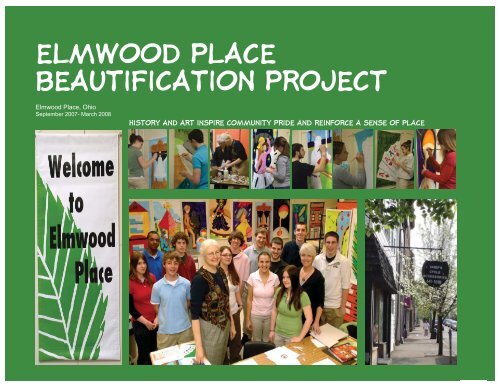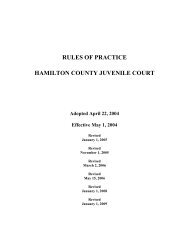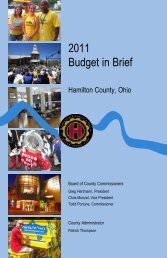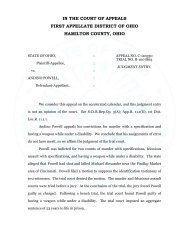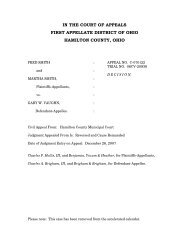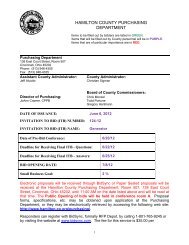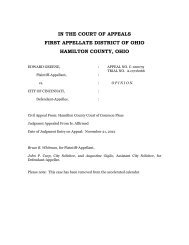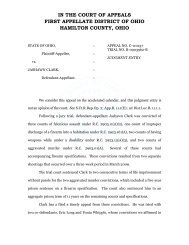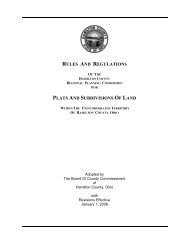Final Book.indd - Hamilton County, Ohio
Final Book.indd - Hamilton County, Ohio
Final Book.indd - Hamilton County, Ohio
- No tags were found...
Create successful ePaper yourself
Turn your PDF publications into a flip-book with our unique Google optimized e-Paper software.
Elmwood PlaceBeautification ProjectElmwood Place, <strong>Ohio</strong>September 2007- March 2008history and art inspire community pride and reinforce a sense of place1
Elmwood PlaceBeautification ProjectThis project has been made possible thanks to grants from the Fine Arts Fund, the Greater Cincinnati Foundation and support from the <strong>Hamilton</strong> <strong>County</strong> RegionalPlanning Commission, First Suburbs Consortium of SW <strong>Ohio</strong>, St. Bernard-Elmwood Place School District, and the Village of Elmwood Place.Participants:Resident Artist: Carol Ann NewsomeArt Teacher: Nancy AndersonStudents: Abie Asher, Bryana Baker, Alex Brown, Alex Bushelman, Josh Cox, Anastasia Ellison, Rebecca Justice, Jacob Lawhorn,Alex Musal, Chad Poppelwell, Damion Watson, Maggie Martin, Matt Spears,Clayton Hightower and Samantha McCormickCourtney Combs assisted with the painting of the bannersPhotography: Caroline Statkus (students painting), Joe Simon (banners) and Joseph Fuqua II (group cover photo)Map: K.D. RexCatalogue: cover design and layout by Jay Springer, editor Catalina Landivar-SimonField Inspection and Pole Utilization Approval: Kathy Marksberry Duke-EnergyBanner Construction and Instillation: Greg Buchtmann B&D GraphicsProject Management: Catalina Landivar-SimonSt. Bernard-Elmwood PlaceHigh SchoolFirstSuburbsConsortiumOF SOUTHWEST OHIO2
descriptionWelcome to Elmwood PlaceWhere is Elmwood Place? Well..., sixteen young artists from St. Bernard-Elmwood Place High School are helping you fi nd the answer. When the Village of Elmwood Place prepared a RevitalizationPlan a couple of years ago, one of its clearly stated goals was to “build and establish a strong recognizable community identity as a welcoming traditional neighborhood in the heart of theGreater Cincinnati area that is a great place to live, work, shop and invest.” The Plan adds “...efforts need to be made to create community building activities that focus on improving the quality andatmosphere of neighborhoods and integration of all residents.”The question was: how to make it happen?The Village of Elmwood Place and the St. Bernard-Elmwood Place School District collaborated on a project involving 11th grade art students. The students, themselves residents of Elmwood Placeand St. Bernard, designed artwork for street banners inspired by the stories told by the fi rst Elmwood Place residents compiled in the 1946 book “Elm Tree Days” by Mildred Schulze, librarian ofthe Elmwood Place Branch of the Public Library of Cincinnati and <strong>Hamilton</strong> <strong>County</strong>. The stories paint a vivid image of the hardships and ingenuity of the fi rst settlers, their way of life, their sense ofcommunity, and their sense of humor. Richard Ellison, Village historian and current mayor of Elmwood Place, fi lled in the historical gaps from the 1940’s to the present day. The result of this collaborativeapproach is thirty-seven original hand-painted banners. The young artists worked under the guidance and supervision of Carol Ann Newsome, artist in residence and Nancy Anderson,arts teacher. Banners have been placed on Vine Street and Township Avenue in Elmwood Place. A digital catalogue is available on the Village website with information about the designs, artists,and history behind each design.Let’s celebrate!The community came together to celebrate as artists and instructors were recognized by Elmwood Place at its April 8, 2008 Council session. Greater Cincinnati now has an art exhibit to enjoy thatis also a marker and reminder to residents and passersby alike that “Elmwood Place is Here.”The expected and unexpected consequences of this projectIt was an exciting and fun experience: students learned graphic design and art techniques as well as the history of the Valley and of Elmwood Place in particular. Carol Ann Newsome was extraordinaryin empowering the kids and helping them discover the artist within. Nancy Anderson proved to be a patient, encouraging and nurturing instructor who kept the students motivated. A localbusiness, B & D Graphics, was very accommodating in meeting the requirements of this unique “banners” project. Kathy Marksberry, a fi eld technician from Duke Energy, spent many hours inspecting,identifying and approving pole usage. Her thorough work not only identifi ed poles that could be used, but also nine poles that could be removed and four to be replaced due to deterioration.The combined effect will be a cleaner streetscape. Expertise and dedication, beyond the call of duty, of staff of the <strong>Hamilton</strong> <strong>County</strong> Regional Planning Commission got this project rolling. Theexpectation is positive media coverage and many visitors to Elmwood Place to enjoy the artistic banners.This project was made possible by grants from the Fine Arts Fund and Greater Cincinnati Foundation, support from Dr. Mimi Webb, St. Bernard-Elmwood Place School District Superintendent,Richard Ellison, Mayor of Elmwood Place, the <strong>Hamilton</strong> <strong>County</strong> Regional Planning Commission and the First Suburbs Consortium of Southwest <strong>Ohio</strong>.Catalina Landivar-Simon, AICPProject ManagerSenior Planner – <strong>Hamilton</strong> <strong>County</strong> Regional Planning CommissionPage 13
Pole 1Artist: Alex BushelmanSubject: TrainWhen the train whistle blewThe speediest land transportation from Elmwood Place to Cincinnati in those early days was by train, and travelers had their choice of tworailroad lines. The C.H. & D. (now CSX line), established in September 1851, traversed the west side of Elmwood, along McGregor Avenue;and the Dayton Short Line (the Busy Bee) (now the Norfolk Southern Railroad), originally chartered in March of 1845, traversed the eastside, along what is now Elmwood Avenue. Nettie Crowther Lank, one of the fi rst settlers in the village, recalls walking through the mud of1876 to the C.H. & D. platform to wait for a train, and fl agging it with a handkerchief. At night, she says, people waved lighted pieces of paperto attract the engineers’s attention. By 1888, thirty-six passenger trains stopped daily at Elmwood, and railroads were preferred for theirspeed and convenience, to canal or horse and buggy travel.Source: ELM TREE DAYS, by Mildred Schulze - VI/71-72Pole 2Artist: Chad PoppelwellSubject: FishingSports lovers had their private brands of entertainment, too. Witness the Elmwood Fishing Club, operating on Chester and Ross lakes, andBroxterman’s Basin. Its motto was “Three minnows to a man.” Georgie Hessloehl was presiding offi cer; Billy Moss and Willie Rodenbeck werequartermaster; and Hery Krais was chief cook. Chester Lake was on what became the grounds of the Werk Soap Plant on Murray Road, andon the opposite site were Ross Lake, the sand pit and Broxterman’s Basin.Source: ELM TREE DAYS, by Mildred Schulze - VIII/101 and VI/67Pole 3Artist: Rebecca JusticeSubject: Slate Roof HouseLocal ArchitecturePage 24
Pole 4Artist: Anastasia EllisonSubject: Foundry 1 (Crucible)Up to 1888, the farms, the little stores, and special trades supplied people with a means of livelihood, but when the Cincinnati Glue Companymade its entrance, larger industry began. […] Largest industry to make its entrance was the old Laidlaw Dunn-Gorden Pump Company, whichbought a twelve-acre tract on the southern boundary of Elmwood in 1894 and built a modern plant. In 1916, it re-organized and became theLaidlaw Works of the Worthington Pump and Machinery Corporation.Source: ELM TREE DAYS, by Mildred Schulze - VIII/85Pole 5Artist: Josh CoxSubject: Canal & LocksAlong the Old TowpathThe most scenic mode of travel through the Valley was the Miami and Erie Canal, which traverse the Eastern border of Elmwood on its windingroute to Lockland and the towns beyond. The high stone walls which line both sides were overhung by foliage. Beyond them the traveler sawthe farm lands, orchards, and little wooded nooks of the Valley. Along one shore ran the towpath, traveled by the mules which pulled the canalboats after them…. The boats taking day excursions had long, narrow cabins equipped with seats inside, but passengers sat on deck whenthey could to enjoy the view. A favorite ride was from Cincinnati to Lockland, where the traveler thrilled to the sensation of being lowered orraised into the locks.Source: ELM TREE DAYS, by Mildred Schulze - VI/65Pole 6Artist: Bryanna BakerSubject: Bell TowerThe Independent Fire Company (IFC) purchased a bell and hung it in a small tower on top of John Weidig’s paint shop which stood betweenthe back yards of the Weidig family at 312 Linden Street and the Chapman family at 315 Walnut. On August 21, 1885, the bell was rung forthe fi rst time, notifying the villagers that there was a bell in town that could make a noise. The fi rst time the bell rung to announce a fi re was onSeptember 22, 1885 when a fi re erupted in a cottage on Locust Street near Highland Avenue.Source: ELM TREE DAYS, by Mildred Schulze - VIII/41-42Page 35
Pole 7Artist: Anastasia EllisonSubject: Wigwam Tea SocialHow the Union Chapel BeganThe fi rst settlers were deeply religious people. The Union Chapel was a community effort that allowed at one point that four different denominationsremained together under the same roof, which taught them tolerance which makes for a peaceful community. Determination andhumor characterized the building of the fi rst church. The fi rst fund-raiser took place in a leaky shack in a severe rainstorm. Servers heldumbrellas over patrons.Source: ELM TREE DAYS, by Mildred Schulze - VII/28Pole 8Artist: Anastasia EllisonSubject: Foundry 2 (The Pour)Local Industry : Doubtless the factories contributed to an amazing growth in population during the next forty years, which resulted in Elmwood’sbecoming the most densely populated square mile of <strong>Hamilton</strong> <strong>County</strong> in 1943. But the birth of industry foretold the loss of Elmwood’s countryquaintness. Though some residents continued to work in Cincinnati after 1900, it was evident by then that one could earn an adequate livingin the Valley.Source: ELM TREE DAYS, by Mildred Schulze - VII/86Pole 9Artist: Carol NewsomeSubject: Stacy ManufacturingComing to Elmwood in 1902, the Stacey Manufacturing Company, engineers, fabricators, and constructors, occupied the site of the Balzertruck garden on Township Avenue. Begun close to one hundred years ago, this fi rm started at Front and Mill Streets, and was establishedin Elmwood under the presidency of Henry Ranshaw. Many industries made Elmwood Place the densest populate square mile in <strong>Hamilton</strong><strong>County</strong> in 1943.Source: ELM TREE DAYS, by Mildred Schulze - VII/86Page 46
Pole 10Artist: Jacob LawhornSubject: Truck GardenAll along the Pike that later became Vine Street, from Carthage through Elmwood to Ludlow Grove, were vegetable gardens owned by Germanfarmers, who sold in the city markets, as well as kept the village supplied. First on the site of the Elmwood school and later on the corneropposite, lay the Kluempke truck farm. The daughter, Kate Kluempke, now Mrs. Schwettman, delivered milk in the village, walking from doorto door. Farther down Vine, near Township, was the Herman Blom Truck garden; and on Township, at the site of the Stacey ManufacturingCompany, was the Balzer vegetable farm, previously owned by the Kuderers. Below these, on the stretch between Blade Avenue and MurrayRoad, lay the fertile lands of Henry Reddert and Henry Will. Other prominent farmers on the outskirts of Elmwood were: the Bischoffs, theRuffners, and the Hettricks, along the canal; the Siemerings, the Hodapps, the Busams, and the Thielmeyers, along the Millcreek. The Thielmeyerdairy covered 120 acres of the Este Estate, and existed as far as 1868. The father, Dietrich Thielmeyer, passed it onto his son Henry,who later purchased a coal business in Elmwood and became a well known merchant.Source: ELM TREE DAYS, by Mildred Schulze - VII/79-80Pole 11Artist: Samantha McCormackSubject: Elephant in Church… probably the most exciting show that Elmwood children ever saw was the elephant chase of 1905, which nobody planned and nobody paidan admission to see. It is well recalled by Mrs. Ladru Hill Hill, who tells the story. “In the spring of 1905, the Hagenbeck-Wallace Circus Company,abandoning winter quarters at the Carthage Fair Grounds, brought their animals to the Big Four Railroad siding at Oak Street, Elmwoodfor re-loading. It was a Sunday morning, and the Negro Baptist Church was holding services. Just as the elephants were walking up a gangplankinto a freight car, a fast express whistled for the crossing and so terrifi ed their leader that he broke loose, escaped from the gang-plank,and disappeared behind the church. He was followed by approximately seven others, who played “ring around a rosy,” about the church whiletheir trainers were frantically trying to re-capture them. Pandemonium let loose inside the building and no wonder! It is said that one elephantput his head through an open window. “Source: ELM TREE DAYS, by Mildred Schulze - VIII/95-96Pole 12Artist: Rebecca JusticeSubject: Red HouseLocal ArchitecturePage 57
Pole 13Artist: Jacob LawhornSubject: “Hoo-dooed” PantsSwimming, wading, fi shing, boating were favorite pastimes when school was out. Mothers who lost track of their children went searching alongthe canal banks. An anonymous writer of the HERALD describes a twelve-year-old boy’s usual Sunday afternoon as he remembered it fromhis own childhood. “I and other of my chums used to walk over the hills and through the woods, and when we were hot, we’d stop to drinkfrom springs beneath the beech trees. I can remember taking one of these walks when winter was setting in. I had on a fl annel shirt and mythird-best pair of pants. We came to a small creek, and I made a leap over the rocks but missed my footing. I landed in a bead of loam andwas mud up to my hips. There was nothing to do but leave my pants behind and hurry home in my underwear. Those pants must have beenhoo-dooed. Seems to me I saw them a year later hanging on a tree above the creek bed and fl irting with the wind as it whistled around thecorner This, my friends, is a little of the unknown history of some of the pioneers of your town.” (written March 1,1888).Source: ELM TREE DAYS, by Mildred Schulze - VI/67 and VIII/93Pole 14Artist: Damion WatsonSubject: Bloody RunIn the spring of 1794, John Ludlow, half-brother of Israel, built some cabins on the east side of Millcreek just south of the Buckeye TrottingGrounds. (The Ludlow mansion later stood on this site, which was approximately where the research buildings of the Procter and GambleCompany are located.) Riders stopped here for hospitality on their long journey through the Valley. One morning, a Captain Jacob White andhis party of three others proceeded not more than half a mile beyond Ludlow’s cabins when they heard some shots in the distance and turnedback in confusion. A short time later, two pack-horsemen in the Government service came galloping down the road to report what happened.There had been four of them, but when they stopped to let the horses drink at a creek, they were attacked by Indians. Captain White and thetwo pack-horsemen sought help from John Ludlow, and returning to the creek, rescued a badly wounded soldier and buried the one who haddied. Thus the stream was called “Bloody Run,” and it now peaceful pursues its course beneath a bridge on the east side of Vine Street, notfar from Murray Road.Source: ELM TREE DAYS, by Mildred Schulze - VI/14Pole 15Artist: Clayton HightowerSubject: Swinging BridgeBeyond the [Mill] creek lay the fertile dairy lands of the Thielmeyer family, the Hodapp, Busam and Siemering farms, where on many Sundayafternoon picnics were held. At the foot of Locust Street stretched the famous Swinging Bridge over the Millcreek, a suspension foot-bridge,supported by cables. Though built by the Township under the supervision of Peter Surr, a trustee, it was actually constructed by Joseph Busamand George Hodapp, who owned adjoining farms and needed a means of transportation to the east side of the creek. The Swinging Bridgewas both graceful and practical, besides providing a little quiver of excitement to those who swayed lightly from side to side as they trippedacross. It was the only method of getting over the Millcreek to Elmwood, except by wading.Source: ELM TREE DAYS, by Mildred Schulze - VI/71Page 68
Pole 16Artist: Clayton HightowerSubject: IFC Volunteer FiremanThe IFC (Independent Fire Company) was the fi rst form of community organization. This volunteer fi re department is still an important part ofcommunity life.Source: ELM TREE DAYS, by Mildred Schulze - VIII/41Pole 17Artist: Clayton HightowerSubject: Elephant Chase… probably the most exciting show that Elmwood children ever saw was the elephant chase of 1905, which nobody planned and nobody paidan admission to see. It is well recalled by Mrs. Ladru Hill, who tells the story. “In the spring of 1905, the Hagenbeck-Wallace Circus Company,abandoning winter quarters at the Carthage Fair Grounds, brought their animals to the Big Four Railroad siding at Oak Street, Elmwood forre-loading. It was a Sunday morning, and the Negro Baptist Church was holding services. Just as the elephants were walking up a gang-plankinto a freight car, a fast express whistled for the crossing and so terrifi ed their leader that he broke loose, escaped from the gang-plank, anddisappeared behind the church. He was followed by approximately seven others, who played “ring around a rosy,” about the church while theirtrainers were frantically trying to re-capture them. Pandemonium let loose inside the building and no wonder! It is said that one elephant puthis head through an open window. “ “<strong>Final</strong>ly, the trainers veered the elephants away from the church, and they lumbered down Oak Street.[…] These elephants covered miles in nothing fl at, even fording the Millcreek….”Source: ELM TREE DAYS, by Mildred Schulze - VIII/95-96Pole 18Artist: Anastasia EllisonSubject: Torch BearerBorn of fear and prospering on excitement, the bucket brigade became the second important organization to rise in the village [….] Villagersorganized the Independent Fire Company (IFC) May 22, 1885. Before streetlights were installed, young boys of 16 to18 carried lanterns tolight the way for fi re fi ghters at night.Source: ELM TREE DAYS, by Mildred Schulze - VIII/41-44Page 79
Pole 19Artist: Alex BrownSubject: Happy FaceHappy memories of simpler times were evoked by residents of Elmwood Place and retold by Mildred Schulze in her book “Elm Tree Days.”Pole 20Artist: Matt SpearsSubject: Hank EdwardsOn local clubs and organizationsThere were “The Clippers,” remembrance of which is so greatly relished by Will M. Haney, a pitcher for the team. The club practiced on theKuderer’s Woods diamond and played on the grounds of the Harkness and Cowing Chemical Company. Sometimes the Clippers traveled asfar as <strong>Hamilton</strong> for a Sunday game. Incidentally, Mr. Haney introduced the fi rst curved ball pitched in Florida some years later, and believeshe owes his skill to experience with the Clippers.Another Elmwood Place native, Hank Edwards (1919-1988) was 22 years old when he broke into the big leagues with the Cleveland Indians.He also played for the Cubs, Dodgers, Reds, White Soxs and the Browns.Source: ELM TREE DAYS, by Mildred Schulze - VIII/101; Baseball Almanac.comPole 21Artist: Nancy AndersonSubject: StreetcarBy the late 1800’s Street transportation to other points was in its infant stage. E.J. Arlinghaus remembers a horse-drawn conveyance withbenches that took the city-bound traveler as far as the Zoo. From there he went to Cincinnati by street car. With the passing of time, VineStreet saw many improvements. The horse-drawn tally-ho gave way to the electric street car, which at fi rst ran only to Oak Street, and thenwas extended to Carthage. At one time, streetcars were a popular form of transportation.Source: ELM TREE DAYS, by Mildred Schulze - VI/73-75Page 810
Pole 22Artist: Samantha McCormickSubject: DancersTeen-age entertainment in the 1880s may look a little quieter than “swing” and “boogie-woogie,” but dances and boatrides were just as excitingto those jaunty maids wearing pompadours as they are to the pig-tail girls of today [1940s]. Because they had no “juke-boxes,” the boysprovided their own music, and when they were tired of a banjo or an accordion, they hired the little man with the street piano to come and play.Like an organ-grinder, he went through the village on a summer evening, selling his music and sometimes staying till dark on one particularporch, while the guests danced on the sidewalk beneath gas lamps to the ragtime he ground out.Source: ELM TREE DAYS, by Mildred Schulze - VIII/97Pole 23Artist: Samantha McCormickSubject: GypsyAmong Favorite and sometimes forbidden childhood pastimes was a visit to the gypsy camp on the borderline between Elmwood and Carthage(approximately the Carthage Mills area). It was fun to see how the gypsies lived. […] The gypsies did not seem to mind at all their lifeof public exhibition, as long as enough grown-ups came to their fortune-telling tents. They did their shopping in the village, both extravagantlyand well, (…) during the spring fl oods, they moved closer to Elmwood.Source: ELM TREE DAYS, by Mildred Schulze - VIII/95Pole 24Artist: Maggie MartinSubject: 4 of a KindElmwood Place was once a center for gambling in Cincinnati. Ike Hyams was known as the “King of the <strong>Book</strong>ies” in Cincinnati. He operatedhis gambling operation in Elmwood Place from the mid 1940’s to mid 1950’s. His place of business was the Valley Cigar Store located exactlywhere Gilbert’s Furniture is located (Vine Street at Maple Street). He later went into the hardware business, then the furniture business.Gilbert’s originally was Hyams Furniture. Gilbert bought out the business.Source: Mayor R. EllisonPage 911
Pole 25Artist: Maggie MartinSubject: Lucky SevenElmwood Place was once a center for gambling in Cincinnati. Ike Hyams was known as the “King of the <strong>Book</strong>ies” in Cincinnati. He operatedhis gambling operation in Elmwood Place from the mid 1940’s to mid 1950’s. His place of business was the Valley Cigar Store locatedexactly where Gilbert’s Furniture is located (Vine Street at Maple Street). He later went into the hardware business, then the furniture business.Gilbert’s originally was Hyams Furniture. Gilbert bought out the business.Source: Mayor R. EllisonPole 26Artist: Bryanna BakerSubject: DoorLocal architecture detail of 6309 Vine Street. Door of Italianate/Colonial Revival style building. This rather unusually detailed brick building isa good unaltered example of a professional offi ce or urban home dating from c. 1890.Source: HISTORIC INVENTORY OF HAMILTON COUNTY June 1991. Elmwood Place VS/5Pole 27Artist: Alex MusalSubject: Bonfi reWhen the “Family Feeling” BeganProbably July 4, 1877 was the fi rst day of public celebration in Elmwood. By that time there were enough settlers to organize community activities;and on this summer evening, which happened to be chilly, all of them gathered at the Commons (Cedar Street) before a huge bonfiremade of shavings. The children were delighted by the spray of a few Roman candle balls and by the sputtering of fi recrackers, but the woodfi re was the showiest part of the program. Like one big family they gathered around to sing patriotic songs. This was the beginning of thatfriendly spirit which united the village in a common purpose.Source: ELM TREE DAYS, by Mildred Schulze - VI/19Page 1012
Pole 28Artist: Damion WatsonSubject: Geisen’s Candy Store - 6313 Vine Street (circa 1890)In the fi rst 10 years of Elmwood’s development, little stores sprang to life on the Pike. […] A new school in 1886 may have given life to MollieStortz’s Candy Store, selling a full line of school supplies, along with the sour-balls, the licorice whips, and peppermint sticks that went homein striped bags. Known as “Candy Mollie,” Mrs. Stortz had the temper of a Tartar. The bad boys of the village teased her into a fi t of fury andalways disappeared at the tail end of ther profanity. Her lack of self-control actually gained her business instead of losing it; so did her policyof giving six cents’ worth of candy for fi ve.In the 1940’s through the 1950’s kids from Elmwood Place patronized Geisen’s Candy Store. The store was located on Vine Street betweenLinden and Locust approximately across from where today stands Dirty Jack’s Bar & Restaurant” recalls Mr. Richard Ellison, Village Historianand current Mayor of Elmwood Place.Source: ELM TREE DAYS, by Mildred Schulze - VII/80-81Pole 29Artist: Josh CoxSubject: GingerbreadLocal ArchitecturePole 30Artist: Alex MusalSubject: Elm LeafElmwood Place was named for it’s elm trees. A massive elm tree was located on the site of 306 Township Avenue. The trunk measured 15feet in circumference at a point six feet from the ground. On May 13, 1888, when the tree was approximately one humdred years old, a severestorm rocked its topmost branches and they fell on the roadway close to the Bee Line railroad-ties. The remainder of the tree was removedby the Village for a road expansion.Source: ELM TREE DAYS, by Mildred Schulze - VI/17Page 1113
Pole 31Artist: Abie AsherSubject: Spring BouquetWith tender memory, Emily Heun London, of Alhambra, California, adds up the score of childhood pleasures which the canal and lakes affordedher. She was fi ve and one-half years of age when she moved to Elmwood Place. She reminisced: “…then came spring in all its gloryto unlock the fertile soil, and we children would pick big bunches of jhonny-jump-ups, spring-beauties, buttercups, and violets in every vacantfi eld. The lovely hills and dales across the creek were abounding with bleeding-hearts, Dutcham’s-breeches, May-apple blossoms, and varietiesof lovely fern….[…]. All year around was like an earthly paradise in the lovely Valley during the 1880’s.”Source: ELM TREE DAYS, by Mildred Schulze - VI/70Pole 32Artist: Chad PoppelwellSubject: GearsGears and Ballbearing manufacture was an important local industry. Many industries made Elmwood Place the densest populated squaremile in <strong>Hamilton</strong> <strong>County</strong> in 1943.Source: ELM TREE DAYS, by Mildred Schulze - VIIPole 33Artist: Abie AsherSubject: GaslightGaslights can still be seen along Vine Street. It was a common occurrence for a man to step out of his house at night, well-groomed for apublic meeting, and to arrive so covered with mud that he was hardly presentable. Usually he carried a street lantern to guide the way; if hedidn’t, he was lucky to get there at all. In November of 1888, a fi rst fund for the purchase of lamps along McGregor Avenue and Maple Street,the direct line from the C.H.&D. Depot to the schoolhouse was started. Soon other streets followed suit.Source: ELM TREE DAYS, by Mildred Schulze - VI/73Page 1214
Pole 34Artist: Alex MusalSubject: Elm BranchElmwood Place was named for it’s elm trees. A massive elm tree was located on the site of 306 Township Avenue. The trunk measured 15feet in circumference at a point six feet from the ground. On May 13, 1888, when the tree was approximately one humdred years old, a severestorm rocked its topmost branches and they fell on the roadway close to the Bee Line railroad-ties. The remainder of the tree was removedby the Village for a road expansion.Source: ELM TREE DAYS, by Mildred Schulze - VI/17Pole 35Artist: Alex MusalSubject: Yellow HouseLocal architecture. The first houses were all yellow, and a newcomer became slightly confused when he asked for a certain family and wasdirected to “that yellow house over there.”Source: ELM TREE DAYS, by Mildred Schulze - VI/17Pole 36Artist: Josh CoxSubject: TowerLocal architecture circa 1885. 6101 Vine Street is on the Northwest corner of Vine and Walnut Streets. Leinenberg’s Butcher Shop used tobe here, but the Leinenberg’s were better known for their horses which used to pull the fi re truck. This structure is a signifi cant example of aQueen Anne commercial building.Page 1315
Pole 37Artist: Alex BushelmanSubject: Tool and SteelMany industries made Elmwood the densest populate square mile in <strong>Hamilton</strong> <strong>County</strong> in the 1940’s.Source: ELM TREE DAYS, by Mildred Schulze - VII/86Page 1416
Utility PoleLocations alongTownship & VinePage 1517W66THSTFAIRPARKAVE66TH STW65THSTW 64TH STW63RDSTROSEWOOSTLEBANONSTELEBEECH STE66TH STELMWOOD AVBEECH AVMAPLE STOAK STSPRUCE STVINE STPOPLAR STWALNUT STHIGHLAND AVSYCAMORE STLINDEN STLOCUST STLOMBARDY STCEDAR AVTOWNSHIP AVTOWNE STI-75SILVER STCHESTNUT STPROSSER AV4535222128272989101112131415TOWNSHIPAVJAMES STHELEN STBLADE STVINE ST336373463316191817202324MAPLST257303132MCGREGOR AV12Elmwood Place Banner Location Study26LegendBanner LocationTYPEUtility, WoodUtility, MetalpavementBuildingsMill CreekCorporate Lines0 50 100 200 300 400Feetprepared by kd 3/21/2008
18 16
17 19
.We are making history every day...And Mildred Schulze proved it. Her diligently piecingtogether and recording the oral history of ElmwoodPlace from the fi rst settlers to the 1940’s became alegacy for future generations.Miss Schulze was a great storyteller. Through her,young kids and teenagers from the late 1800’s toldtheir stories to the students of the 2008 11th gradeart class. Those stories elicited many questions, quitea few chuckles, and an understanding of ElmwoodPlace’s past.Today, Elmwood Place and St. Bernard’s teenagersare making history themselves. They have reinterpretedthe stories as visual art and have built a bridgetoward a strong community.Wondering what Miss Schulze looked like?The picture on the right comes from her scrapbookkept by the Elmwood Place Branch of the Cincinnati-<strong>Hamilton</strong> <strong>County</strong> Library.March 200820


